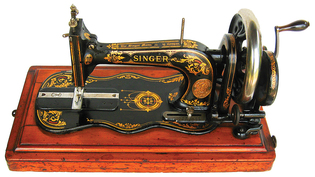
Thomas L. Lentz ’64MD
By 1860, the Singer company had become the world’s largest manufacturer of sewing machines. The Singer Model 12 was the best-selling sewing machine of its time; this lacquered and decorated example, beautifully preserved, was made in 1885.
View full image
The history of the sewing machine stretches back at least a few centuries, but the technology has taken on new meaning during the global pandemic. This lovely example is an antique Singer sewing machine from our History of Science and Technology collection at the Peabody Museum. When I started sharing it with Yale students and coworkers in February 2020, it most often evoked stories about treasured family sewing machines. By the following month, it had also become an evocative symbol of the pandemic: people everywhere had started sewing and sharing fabric masks, doing what they could to help stem the spread of COVID-19.
Humans have been sewing manually for thousands of years, but by at least the 1700s, inventors tried to mechanize the process. The British cabinetmaker Thomas Saint is thought to have produced the first workable sewing machine in 1790, in order to stitch leather, but it did not advance beyond a patent model. The French tailor Barthelemy Thimonnier patented the first practical sewing machine in 1830 and used it to sew army uniforms, but a mob of tailors destroyed the inventor’s factory more than once.
In 1846 Elias Howe of Massachusetts was awarded the first US patent for a sewing machine, but he could not find investors, and other entrepreneurs infringed upon the patent. They included Isaac M. Singer, who patented the first rigid-arm sewing machine. The two men ultimately compromised, with Singer paying a royalty to Howe, and the Singer company went on to become the world’s largest sewing machine manufacturer by 1860. Singer was awarded 20 additional patents, built lavish showrooms, and spent millions of dollars on advertising. He also pioneered the use of the installment plan, allowing more consumers to afford his high prices, which started at $75.
This beautiful Singer Model 12 sewing machine was made in 1885, at the company’s factory in Elizabeth, New Jersey. Singer introduced the Model 12 to the national market near the end of the Civil War in 1865, and he continued producing it until 1902. (This well-preserved specimen was generously donated by Thomas L. Lentz ’64MD, Professor Emeritus of Cell Biology at the Yale School of Medicine.)
The Model 12 was the best-selling sewing machine of its time, being the first easy-to-use and reliable lockstitch sewing machine, and competitors frequently imitated it. It was called a “fiddleback,” because of the shape of its base. This example is made of cast iron painted in japan black lacquer and decorated with a pattern now known as “Acanthus leaves.” It has a finely made walnut lid, which latches onto the machine base for portability. Although this one has a hand crank, the machines could also be operated by treadle or foot pedal.
Sewing machines like this one took off during the industrialization of America—speeding up the stitching of all kinds of products including clothes, tents, and umbrellas. The trend fostered the spread of ready-made clothing, and it somewhat eased the burden of domestic sewing, which mainly fell on women.
I started displaying this machine at the Collection Studies Center at Yale’s West Campus because a Yale student, Julia Holz ’20MA, was researching it for a seminar taught by Professor Paola Bertucci, the collection’s faculty curator. Holz, whose degree is in East Asian Studies, is still using the Singer sewing machine her grandmother bought during the 1940s. We had a wonderful time comparing her machine to its ancestor. The history of the humble sewing machine is a living history, and one that takes on additional meaning for each successive generation.
 loading
loading
1 comment
-

Eunice Palffy-Muhoray, 3:29pm July 23 2020 |  Flag as inappropriate
Flag as inappropriate
The comment period has expired.Hi Alexi,
I know you know who I am and I just wanted to say I enjoyed this. I have two well used versions of this machine that I am working on getting back into shape after years of neglect so it was extra nice for me to see one so well taken care of by somebody. I’m looking forward to meeting you!
Eunice